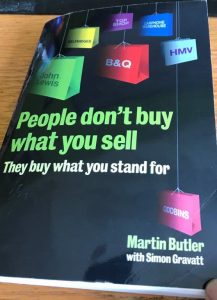It’s been more than 10 years since my final stint as a Group Director at the prestigious Oxford Summer School, and it strikes me how often I call upon one of my favourite sessions to help me write content for RMS.
The session to which I refer was a full day all about Branding & Marketing – hosted by leading branding and marketing guru Martin Butler (ably assisted by a fellow retail expert, Neil Kennedy). I initially thought the day would be a relatively simple affair following a full day of Finance the day before (and another late night in the student bar!), however, it turned out to be quite the opposite…I can assure you, this branding and marketing malarkey really is quite a challenge!
 Even now, a decade on, I don’t confess to knowing that much more about it, however, there was one thing I do remember and that may be because it happens to be the title of one of Martin’s books (which he kindly gave a copy to all delegates and even signed mine for good measure!) “People don’t buy what you sell, they buy what you stand for” – or as he puts it within the book, “It’s not what you sell, but how you sell it”.
Even now, a decade on, I don’t confess to knowing that much more about it, however, there was one thing I do remember and that may be because it happens to be the title of one of Martin’s books (which he kindly gave a copy to all delegates and even signed mine for good measure!) “People don’t buy what you sell, they buy what you stand for” – or as he puts it within the book, “It’s not what you sell, but how you sell it”.
In today’s Multichannel world (or whatever name it is being termed this week) there is plenty of choice as to where to buy the next ‘must-have’ piece of merchandise, but it’s the emotional response to the brand that influences where you end up paying for it.
Facilitating these emotions invariably comes down to the work of marketing – arguably one of the most misunderstood and maligned disciplines of the retail age where all too often we see the trust and strength of both the retailers and products brands undone in a jiffy as inflexible, outdated, spreadsheet constrained ticketing systems to attempt to convey key brand messages and value – What is it I am buying? How much is it? Why is it a great deal? How will it make me feel? Who else buys it? What goes with it? Where can I find out more? So, on and so forth…
In today’s modern supermarket, shoppers are confronted with a different offer every ½ second, yet will buy only 1 out of 500 products available in-store (Source: Phillip Adcock – SBXL). To increase these odds, products must be made more appealing and engaging when on-shelf. The right choice of colour, for instance, can increase product impact by 80%.
Imagery increases preference by 36%, whereas product appearance improves engagement by a whopping 323%. Mix all three together, use the right image to stimulate an emotional response and this figure can be astonishingly high. With shoppers relying on branding and visual cues more than any other ‘sensory stimuli’ the shelf edge remains one of the most valuable pieces of real estate any retailer owns.
If you engage shoppers effectively at the shelf edge you stand to increase promotional effectiveness – if you mix in other brand benefits you easily create a compelling argument for implementing a better shelf edge ticketing system.
To learn how to add ‘brand stickiness’, engineer emotional responses, maximise customer spend and drive brand value contact RMS on +44 (0)2380 816000 or request a demo here
Recent Comments